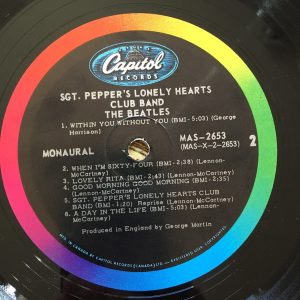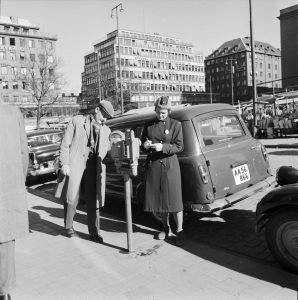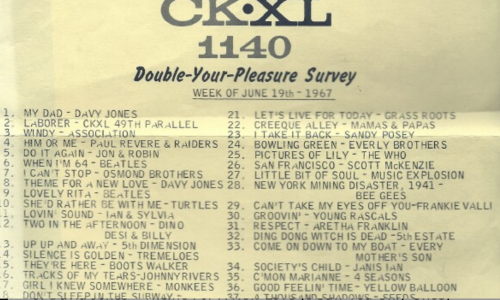#62: Lovely Rita by the Beatles
City: Calgary, Alberta
Radio Station: CKXL
Peak Month: June 1967
Peak Position in Calgary ~ #9
Peak position in Vancouver ~ did not chart
Peak Position on Billboard Hot 100 ~ did not chart
YouTube.com: “Lovely Rita”
Lyrics: “Lovely Rita”
Paul McCartney was born in Liverpool in 1942. He attended the Liverpool Institute High School for Boys and met fellow classmates George Harrison on a school bus. When Paul was 14 his mom died from a blockage in one of her blood vessels. In his early teens McCartney learned to play trumpet, guitar and piano. He was left-handed and restrung the strings to make it work. In 1957, Paul met John Lennon and in October he was invited to join John’s skiffle band, The Quarrymen, which Lennon had founded in 1956. After Paul joined the group his suggested that his friend, George Harrison, join the group. Harrison became one of the Quarrymen in early 1958, though he was still only 14. Other original members of the Quarrymen, Len Garry, Rod Davis, Colin Hanton, Eric Griffiths and Pete Shotton left the band when their set changed from skiffle to rock ‘n roll. John Duff Lowe, a friend of Paul’s from the Liverpool Institute, who had joined the Quarrymen in early 1958 left the band at the end of school. This left Lennon, McCartney and Harrison as remaining trio. On July 15, 1958, John Lennon’s mother died in an automobile accident.
John Winston Lennon was born in Liverpool in 1940. His middle name was after Britain’s current Prime Minister Winston Churchill, during World War II. In 1957, Lennon wrote his first song titled “Hello Little Girl”. It became a Top Ten hit in the UK in 1963 for the Merseybeat band the Fourmost. George Harrison was born in Liverpool in 1943. His father bought him his first guitar in 1956 when Harrison was 13 years old.
Richard Starkey was born in Liverpool in 1940. As a child he was sick with appendicitis, peritonitis and finally tuberculosis. The latter illness had him spend two years in a sanitorium from 1953 to 1955. Out of school for this duration, Starkey remained at home after his return from the sanatorium. He got involved with a skiffle band initially called the Eddie Miles Band which morphed into Eddie Clayton and the Clayton Squares. Starkey next joined Al Caldwell’s Texans which eventually became Rory Storm & The Hurricanes. By the fall of 1959, Starkey changed his professional name to Ringo Starr and his drum solos during their concerts were billed as ‘Starr Time.’ Beginning October 1, 1960, Rory Storm & The Hurricanes began a gig at the Kaiserkeller club in Hamburg, Germany. They alternated sets with The Beatles. On October 18, 1960, with Pete Best on an errand to find drumsticks, Ringo Starr stood in for Best to play a set with McCartney, Lennon and Harrison. This was the first time the Fab Four performed together.
The Quarrymen went through some name changes, including Johnny and the Moondogs. In January 1960, Stuart Sutcliffe joined the band and suggested they name themselves the Beatals as a tribute to Buddy Holly and The Crickets. The name changed to the Silver Beetles in May and in August 1960 they became the Beatles. The name was a cross between the insect cousin of a cricket and a nickname for rock ‘n roll: ‘the beat’. That same month the Beatles hired Pete Best to become the bands drummer. Now a five-piece band, they headed to Hamburg, Germany, on August 17, 1960, for a three-and-a-half month stint. In early 1961 Sutcliffe left the Beatles as they continued to return for more engagements in Germany. On June 22, 1961, Bert Kaempfert produced “My Bonnie”, “Ain’t She Sweet” and eight other songs. Later in 1961, “My Bonnie” climbed to #4 on the Hamburg pop charts and #32 on the German pop charts.
Meanwhile, the Beatles were developing a following back in Liverpool. Between February 9, 1961, and August 3, 1963, the group played at The Cavern Club 292 times. The group got a recording contract with EMI’s Parlophone label in the UK. At the June 6, 1962, studio session, producer George Martin objected to Pete Best remaining with the Beatles due to his poor drumming skills. In August Ringo Starr from Rory & The Hurricanes accepted Paul McCartney and John Lennon’s invitation to became the Beatles new drummer. The first EMI Parlophone single “Love Me Do”/”PS I Love You” climbed to #17 on the UK charts in the fall of 1962. “Please Please Me” climbed to #2 on the UK pop charts in early 1963. And in April 1963 “From Me To You” became the bands first #1 hit on the UK charts staying on top for seven weeks in a row. It became the first Beatles song on the Vancouver pop charts was in June 1963. It charted on C-FUN together with the cover version by Del Shannon. The song stalled at #116 on the Billboard Hot 100, but the Beatles climbed to #14 in Vancouver in July ’63.
In 1963 “She Loves You” topped the UK charts for six weeks and “I Want To Hold Your Hand” wrapped up the year on top for five weeks in the British Isles. Beginning on December 21, 1963, “She Loves You” topped the C-FUN charts for four weeks. It was replaced on January 18 by “Please Mister Postman”.
On the C-FUN charts in Vancouver on January 25 “I Wanna Hold Your Hand” began a six week stint at number-one. On March 7 “All My Loving” took over the #1 spot, subsequently sharing the #1 spot with the B-side “This Boy” through to April 4.
After sixteen weeks at #1 the Beatles were knocked out of the top spot by the Dave Clark Five’s “Bits And Pieces”. During their streak at #1 in Vancouver from December 21, 1963, to April 4, 1964, “All My Loving”/”This Boy” kept the #1 hit in the USA, “Can’t Buy Me Love” stalled at #2 here on the west coast. Between December 14, 1963, and September 17, 1966, the Beatles had up to five songs in the Top Ten in Vancouver for 107 out of 146 weeks.
Beatlemania – the frenzy for all things related to the Beatles from their records, to appearances – officially reached North America with three appearances on the Ed Sullivan Show in February 1964. But in Vancouver the Beatles were already a craze by December ’63. In April 1964 the Beatles released The Beatles’ Second Album. It featured a number of tracks that were hit singles. These included “Thank You Girl”, “She Loves You”, “Please Mr. Postman”, “You Can’t Do That” (also released as a track on A Hard Days Night). In June the German version of “She Loves You” titled “Sie Liebt Dich” began to chart, and became a Top Ten hit in Vancouver in July.
In June the band released the film and soundtrack album A Hard Days Night. The theme song from the film climbed to number one in August. The B-side in North America to “A Hard Day’s Night” was “I Should Have Known Better”. (In the UK the B-side was “Things We Said Today”). Then in July the Beatles released Something New. The album contained the following single releases: “I’m Happy Just To Dance With You”, “I’ll Cry Instead“, “Things We Said Today”, “Matchbox”, “Tell Me Why”, “And I Love Her”, and “If I Fell“.
In 1965 the Beatles had two number-one hits to start off the year: “Eight Days A Week” in March, and “Ticket To Ride” in May. In Vancouver, the B-side “Yes It Is” also charted. In the summer of 1965 the Beatles kept on releasing number-one hits. “Help!” had a B-side titled “I’m Down“. The next release, “Yesterday”, was a number-one hit in Vancouver, as was the B-side “Act Naturally”.
On October 1965, the Beatles were back on top of the pop charts with “Yesterday”, and “Day Tripper”/”We Can Work It Out” in December. In early 1966 the Beatles were back in the Top Ten in Vancouver with “Michelle”/”Norwegian Wood”. Their next chart-topper in Vancouver was “Nowhere Man”. The B-side, “What Goes On”, was also a hit in the city.
In March 1966, John Lennon had an an interview with Evening Standard reporter Maureen Cleave. Lennon commented, “Christianity will go. It will vanish and shrink … We’re more popular than Jesus now—I don’t know which will go first, rock and roll or Christianity. Jesus was all right but his disciples were thick and ordinary.” The comment was yawned at in Britain, but it caused a furore when it was reported in Datebook’s August edition in America. Suddenly there were protests that involved the burning of Beatles records. The Ku Klux Klan staged protests against the Beatles and nailed their albums to a wooden cross. There were also death threats against Lennon. This development was a catalyst for the band’s decision to cease touring. On August 19th two concerts were scheduled in Memphis, Tennessee. Both were cancelled by the city council who wouldn’t let municipal facilities be used by people who were trying to “ridicule anyone’s religion.” Meanwhile, the Fab Four had more hit records including “Nowhere Man” and “Paperback Writer”. The B-side to “Paperback Writer” was “Rain“.
Next up, the Beatles released “Yellow Submarine”/”Eleanor Rigby”. In 1967 the band enjoy Top Ten hits with “Penny Lane”/”Strawberry Fields”, “All You Need Is Love” and “Hello, Goodbye”/”I Am The Walrus”. That year the band released Sgt. Pepper’s Lonely Hearts Club Band, which topped the Billboard 200 Album charts for 15 weeks. From the album a number of non-single album charts made a few Top 40 AM radio markets based on listener requests. One of these was “Lovely Rita”.

“Lovely Rita” was written by Lennon and McCartney. In the book, Beatles in their Own Words, Paul McCartney describes how he wrote “Lovely Rita” as if he fell for a meter maid while she was taking his plate number. Said Paul: “I was bopping about on the piano in Liverpool when someone told me that in America, they call parking-meter women meter maids. I thought that was great, and it got to ‘Rita Meter Maid’ and then “Lovely Rita Meter Maid’ and I was thinking vaguely that it should be a hate song: ‘You took my car away and I’m so blue today’ and you wouldn’t be liking her; but then I thought it would be better to love her and if she was very freaky too, like a military man, with a bag on her shoulder. A foot stomper, but nice. The song was imagining if somebody was there taking down my number and I suddenly fell for her, and the kind of person I’d be, to fall for a meter maid, would be a shy office clerk and I’d say, ‘May I inquire discreetly when you are free to take some tea with me.’
In England having tea time was a centuries old tradition. A 1935 song titled “Everything Stops For Tea”, actually written by Americans Maurice Sigler, Al Goodheart, and Al Hoffman, depicts the custom of having tea time in England at 4 P.M. Sigler and his pals had fun with the lyrics surmising:
Now I know just why Franz Schubert
didn’t finish his Unfinished Symphony.
He might have written more but the clock struck four,
and everything stopped for tea.”
McCartney and Lennon had fun with the theme, as the shy suitor tells Rita, “when it gets dark I tow your heart away.” He proposes to Rita that they go on a date and have dinner. After the meal is done, when the bill comes, Rita pays it, instead of the suitor. Rita, who in her uniform “looks a little like a military man,” is in charge of setting the pace for the two to get to know each other. Back at her home, the fellow finds he is in the company of not just Rita, but also a couple of her sisters.

Meter Maid in Europe in 1960’s
On the NBC television comedy series Rowan & Martin’s Laugh-In, cast member Barbara Sharma was often featured as an overzealous meter maid (spelled Metre Made) who would ticket anything from baby carriages to trash cans.
“Lovely Rita” peaked at #5 in Seattle, and #9 in Calgary (AB).
In early 1968 the band had another hit single with “Lady Madonna”. The B-side, “The Inner Light”, also charted in Vancouver. The Beatles would become the most influential rock ‘n roll band of the 20th Century. They have sold over one billion records. They began recording upbeat love songs like “I Want To Hold Your Hand” and later composed more complex songs, including on their award-winning 1967 album, Sgt. Pepper’s Lonely Hearts Club Band. The Beatles were on the cusp of whatever was new and were often the trend-setting reason for the next new thing. In 1967 they got involved with Transcendental Meditation. When they released “Hey Jude,” they had one of those rare singles that was longer than 7 minutes climb to the top of the charts. At the time, the standard formula for singles was around two to three minutes in length.
In 1969, the Beatles had more hit records with “Get Back” and “The Ballad of John & Yoko”. The B-side for the latter was “Old Brown Shoe”.
The band’s final hit singles were “Something”/”Come Together”, “Let It Be” and “The Long And Winding Road”. The Beatles split in 1970 after the release of the Let It Be album. Paul McCartney told Howard Stern in 2018 that John Lennon walked into a room one day in 1970 and announced that he was leaving the Beatles.
For more information about the Beatles after the 1970 breakup, see my other articles on the band.
August 9, 2023
Ray McGinnis
Resources:
David Fricke, “Paul McCartney Looks Back: The Rolling Stone Interview,” Rolling Stone, August 10, 2016.
Ben Quinn, “Paul McCartney ‘saw God’ After Taking Drugs During Beatles Heyday,” Guardian, September 2, 2018.
Stephen Rodrick, “Being Ringo: A Beatle’s All-Starr Life,” Rolling Stone, April 15, 2015.
“Interview: John Lennon and Ringo Starr in Los Angeles,” Los Angeles Times, August 23, 1964.
Mick Brown, “A Conversation With George Harrison: The ‘Fab Four’ is Done For, and George Couldn’t be Happier Doing his Own Thing,” Rolling Stone, April 19, 1979.
Dave Laing and Penny Valentine, “George Harrison: The Most Handsome but Underrated Beatle, he Came into his Own as a Solo Artist and Film Producer,” Guardian, December 1, 2001.
“John Lennon Died 35 Years Ago Today: Read Original Associated Press Story,” Billboard, December 8, 2015.
Johnathan Cott, “John Lennon: The Last Interview: Three days before he died, John Lennon talked with ‘Rolling Stone’ for nine hours. For the first time, we present this extraordinary interview,” Rolling Stone, December 23, 2010.
Barry Miles, Beatles in their Own Words, Putnam Pub. Group, 1978.

CKXL 1140 AM, Calgary. Alberta, June 19, 1967 (most of the Top 40)
“Lovely Rita” appeared on the chart the week of June 12, 1967, and climbed to
#9 on June 19th.
For more song reviews visit the Countdown.

Leave a Reply